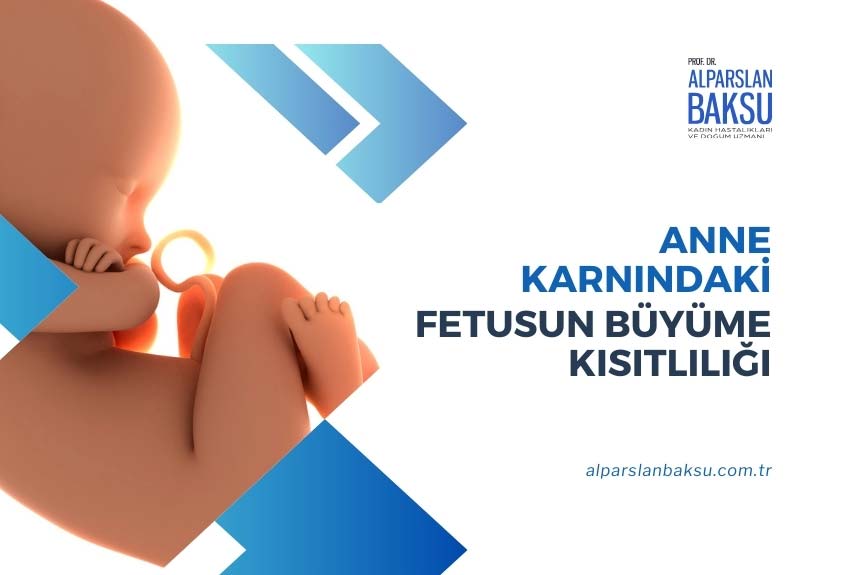The baby in the womb is called "fetus". Situations in which the fetus could not use its required growth potential for various reasons and its development was delayed were formerly called "intrauterine growth retardation" (development retardation in the womb). Today, this definition is called intrauterine growth restriction.
The growth of the baby in the womb can be divided into three main periods. During the first trimester of pregnancy (1st trimester) growth occurs by increasing the number of cells of the fetus (hyperplasia). In the second trimester (2st trimester ) growth occurs with both an increase in the number of cells and an increase in cell size (hypertrophy). In the third trimester (3st trimester), there is only an increase in cell size. In pregnancies with a single baby, the fetus is 14-15 weeks old. 5g per day in the following weeks, 20g in the 10th week, and 32g in the 30nd week. It grows up to .
We can determine that babies born have low birth weight by comparing them with normal development data obtained from thousands of babies born in the same week. A diagnosis of low birth weight or intrauterine growth restriction can be made if the weight of the newborn baby corresponds to the bottom 10% of the average size of babies born in the same week. In this case, we can say that approximately 10% of babies born have low birth weight. While factors effective in the first half of pregnancy generally cause proportional (symmetrical) growth restriction in the fetus, factors effective after the second half may cause disproportionate (asymmetrical) growth restriction.

The main reasons that may lead to proportional growth restriction in the fetus are; chromosomal disorders, congenital structural disorders in the baby, some infections during pregnancy, mother's nutrition, small size of the mother, mother's age, number of births, familial factors, smoking, alkol and cocaine use. The reasons that may lead to disproportionate growth restriction are; Some diseases of the mother (high blood pressure, anemia, lung, heart and kidney diseases, etc.) can be considered as a decrease in the capacity of the baby's partner to carry nutrients, which we call the placenta.
How is the diagnosis made?
Like our country, pregnant women are kept in a regular and specific center. follow-up In cases where they are not present, it may not always be easy to diagnose. Especially if the woman does not remember her last menstrual period, our job will become even more difficult. There are two basic data we will use in diagnosis. The first is the calculation of the gestational week according to the last menstrual date of the pregnant woman, and the second is the calculation of the gestational week according to the ultrasonographic examinations performed correctly in the first three months of pregnancy. It is extremely difficult to make a diagnosis if the woman does not know the date of her last menstrual period or if her periods are irregular and we do not have ultrasonographic measurements of the early stages of pregnancy. For this reason, it is extremely important for pregnant women to keep the documents from their examinations. We compare the data we obtain about the size of the fetus during the ultrasonographic examination with the data obtained during the last menstrual period and the first ultrasonographic examination. If the baby has grown enough over time, there is no problem. These babies should be monitored closely if they have grown less than they should. If the baby's measurements correspond to the bottom 10% of the average values for that week, then we diagnose growth restriction in the womb.
The approximate week of pregnancy can be estimated by measuring the abdomen with a tape measure. 3cm more than it should be according to the week. A rare measurement can diagnose growth restriction in the womb.
How is follow-up done in these pregnant women?
First of all, risk factors that can be treated are tried to be eliminated. Chronic diseases of the mother should be controlled before or at the beginning of pregnancy. Screening for chromosomal diseases should be done. High PAP-A and AFP values and low HCG values measured in these scans should suggest that there may be growth restriction in these pregnancies. Infections experienced by the mother during pregnancy should be carefully monitored and these pregnancies should be monitored more closely.

When a definitive diagnosis is made, these fetuses should be followed with color Doppler ultrasonography, pregnancy fluid amount and NST. If diagnosed pregnant women are working, they should be taken to rest, bed rest and their nutrition should be regulated. If the fetus's stay in the mother's womb exceeds 37 weeks of gestation, the baby is delivered. In the gestational weeks below this, the baby's growth capacity is determined, and close monitoring is carried out depending on whether there is any distress in the womb (which can be determined by Doppler examinations and NST). The critical week is the 34th week of pregnancy. Since the chances of survival of babies delivered after this week are very high, decisions can be made more easily.




Leave a Reply